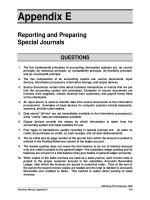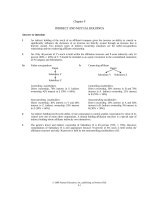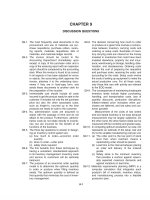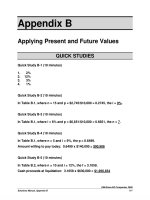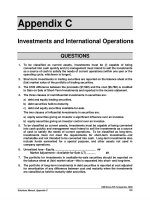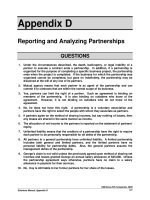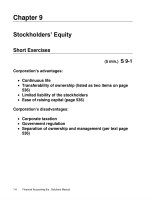Solution manual Financial accounting 6th kieso kimmel ch09
Bạn đang xem bản rút gọn của tài liệu. Xem và tải ngay bản đầy đủ của tài liệu tại đây (1.37 MB, 93 trang )
www.downloadslide.net
Kimmel, Weygandt, Kieso, Trenholm, Irvine
Financial Accounting, Sixth Canadian Edition
CHAPTER 9
Reporting and Analyzing Long-Lived Assets
ASSIGNMENT CLASSIFICATION TABLE
Study Objectives
Questions
Brief
Exercises
1.
Determine the cost
of property, plant,
and equipment.
1, 2, 3, 4
1, 2, 3
1, 2
1A, 2A, 3A
1B, 2B, 3B
4, 6, 7
2.
Explain and
calculate
depreciation.
5, 6, 7, 8,
9, 13
4, 5, 6, 7,
8, 9
2, 3, 4, 5, 6, 2A, 3A, 4A,
8
5A, 6A, 7A,
8A
2B, 3B, 4B
5B, 6B,
7B, 8B
1, 3, 4,
5, 7
3.
Account for the
derecognition of
property, plant, and
equipment.
10, 11, 12
10, 11
5, 6, 7
6A, 7A, 8A
6B, 7B, 8B
7
4.
Identify the basic
accounting issues
for intangible assets
and goodwill.
13, 14,
15, 16, 17
12, 13
8, 9, 10
9A, 10A,
11A
9B, 10B,
11B
1, 4
5.
Illustrate how long18, 19, 20
lived assets are
reported in the
financial statements.
12, 14, 15
10, 11
8A, 10A,
8B, 10B
1
6.
Describe the
21, 22, 23
methods for
evaluating the use of
assets.
16, 17
12, 13
11A, 12A,
11B, 12B
2, 3, 4,
5
Exercises
A
Problems
B
Problems
BYP
Solutions Manual
9-1
Chapter 9
Copyright © 2014 John Wiley & Sons Canada, Ltd. Unauthorized copying, distribution, or transmission of this page is strictly prohibited.
www.downloadslide.net
Kimmel, Weygandt, Kieso, Trenholm, Irvine
Financial Accounting, Sixth Canadian Edition
ASSIGNMENT CHARACTERISTICS TABLE
Problem
Number
Description
Difficulty
Level
Time
Allotted (min.)
Moderate
15-20
Simple
20-30
1A
Classify expenditures.
2A
Determine cost; record property transactions.
3A
Determine cost; calculate depreciation under different
methods.
Moderate
30-40
4A
Calculate and compare depreciation under different
methods.
Moderate
40-50
5A
Calculate depreciation; discuss revision of estimate.
Moderate
15-20
6A
Record acquisition, depreciation, and disposal of
equipment.
Simple
15-20
7A
Record and determine effect of depreciation method
over life of asset.
Moderate
35-45
8A
Record property, plant and equipment transactions;
prepare partial statement of financial position.
Moderate
10-15
9A
Identify intangible assets and goodwill.
Moderate
20-30
10A
Record intangible asset transactions; prepare partial
statement of financial position.
Moderate
30-40
11A
Calculate and evaluate ratios.
Moderate
30-40
12A
Calculate and evaluate ratios.
Moderate
30-40
1B
Classify expenditures.
Moderate
15-20
2B
Determine cost; record property transactions.
Simple
20-30
3B
Determine cost; calculate depreciation under different
methods.
Moderate
35-45
4B
Calculate and compare depreciation under different
methods.
Moderate
40-50
Solutions Manual
9-2
Chapter 9
Copyright © 2014 John Wiley & Sons Canada, Ltd. Unauthorized copying, distribution, or transmission of this page is strictly prohibited.
www.downloadslide.net
Kimmel, Weygandt, Kieso, Trenholm, Irvine
Financial Accounting, Sixth Canadian Edition
ASSIGNMENT CHARACTERISTICS TABLE (Continued)
Problem
Number
Description
Difficulty
Level
Time
Allotted (min.)
Moderate
15-20
Simple
15-20
5B
Calculate depreciation; discuss revision of estimate.
6B
Record acquisition, depreciation, and disposal of
equipment.
7B
Record and determine effect of depreciation method
over life of asset.
Moderate
35-45
8B
Record property, plant and equipment transactions;
prepare partial statement of financial position.
Moderate
10-15
9B
Identify intangible assets and goodwill.
Moderate
20-30
10B
Record intangible asset transactions; prepare partial
statement of financial position.
Moderate
30-40
11B
Calculate and evaluate ratios.
Moderate
30-40
12B
Calculate and evaluate ratios.
Moderate
30-40
Solutions Manual
9-3
Chapter 9
Copyright © 2014 John Wiley & Sons Canada, Ltd. Unauthorized copying, distribution, or transmission of this page is strictly prohibited.
www.downloadslide.net
Kimmel, Weygandt, Kieso, Trenholm, Irvine
Financial Accounting, Sixth Canadian Edition
ANSWERS TO QUESTIONS
1.
2.
(a)
The cost principle requires that property, plant, and equipment be recorded at cost,
which consists of the purchase price, less any discounts or rebates and any other
expenditures necessary to acquire the asset and make it ready for its intended use.
(b)
An asset retirement cost is an estimate of the cost of an obligation to dismantle,
remove or restore a long-lived asset when it is retired. These costs are included in
the cost of property, plant, and equipment and depreciated over the life of the
asset.
Two examples of operating expenditures include routine maintenance and painting of
equipment. Operating expenditures are expensed in the period they are incurred. They
help maintain an asset but do not add additional value, useful life, or economic benefits.
Two examples of capital expenditures include the shipping cost of equipment to its
location of use and testing it to ensure it is ready for its intended use. Capital
expenditures are included as part of the cost of the new equipment. They are incurred
to make an asset ready for use (or to enhance its productivity or extend its life).
3.
Land improvements are structural additions made to the land such as parking lots and
fences. Clearing and grading the land are not land improvements but are part of the
land cost as they are required to get the land ready for its intended use. They would
therefore be capitalized (recorded) in the Land account.
4.
An operating lease allows the lessee to account for the leasing transaction as a rental
and so the lease payments are recorded to Rent Expense, an income statement
account. As a result, neither the asset nor the liability related to the asset is recorded
on the company’s books.
For a finance lease, both the asset and the liability related to the leased asset are
recorded on the company’s books even though the asset is not legally owned by the
party leasing the asset. The asset account involved would be Assets under Finance
Leases and the related liability account would be Finance Lease Liability.
Solutions Manual
9-4
Chapter 9
Copyright © 2014 John Wiley & Sons Canada, Ltd. Unauthorized copying, distribution, or transmission of this page is strictly prohibited.
www.downloadslide.net
Kimmel, Weygandt, Kieso, Trenholm, Irvine
Financial Accounting, Sixth Canadian Edition
Answers to Questions (Continued)
5.
(1)
Depreciation
Expense
(2)
Profit
(3)
Accumulated
Depreciation
(4)
Carrying
Amount
(a) Early years
Straight-line
Same each year Constant charge
(depreciation
expense) to
profit
Increases at a
constant
amount each
year
Declines at a
constant amount
each year
Units-ofproduction
Varies with
number of units
produced
Impact on profit
will vary with the
number of units
produced
Increases at a
Declines at a
variable amount variable amount
based on
number of units
produced
Diminishingbalance
Decreases each
year
Increasing profit
each year
because
depreciation
expense is
lower each year
Increases at a
diminishing
amount each
year
Declines at a
higher amount in
the early years
All three result
All three result
in the same total in the same total
depreciation
impact on profit
expense
All three result
in the same
total
accumulated
depreciation
All three result in
the same ending
carrying amount
(b) Total life
Straight-line,
units-ofproduction,
diminishingbalance
6.
If the residual value was deducted for the diminishing balance method, the carrying
value would never reach the residual value. Applying a fixed percentage rate to a
diminishing balance will always result in an undepreciated balance because a portion of
the depreciable amount will always remain at the end of the period. Residual value is
considered in the diminishing-balance method by ensuring that the asset is never
depreciated below its residual value. In this way we always make sure that the
undepreciated balance (carrying amount) is adjusted to equal residual value at the end
of its useful life. Residual value is subtracted from the cost when using the other
methods because the resulting depreciable cost is needed to determine the annual
depreciation expense.
Solutions Manual
9-5
Chapter 9
Copyright © 2014 John Wiley & Sons Canada, Ltd. Unauthorized copying, distribution, or transmission of this page is strictly prohibited.
www.downloadslide.net
Kimmel, Weygandt, Kieso, Trenholm, Irvine
Financial Accounting, Sixth Canadian Edition
Answers to Questions (Continued)
7.
The straight-line and diminishing-balance methods use annual depreciation rates in
their depreciation calculations. Therefore, the result must be adjusted for any period
less than one year. The units-of-production method does not need to be adjusted for
partial periods as this method multiplies the depreciable amount per unit by the actual
units produced in the period. This reflects how much the asset was used during the
period.
For example, if an asset was purchased July 1 and produced 10,000 units for the
period July through December, it can only produce a result for that six month period
(the company could not have produced units before it purchased the asset) and
therefore does not need to be adjusted for the half year ownership period.
8.
9.
(a)
A company should choose the depreciation method it believes will best reflect the
pattern over which the asset’s future economic benefits are expected to be
consumed. The depreciation method must be revised if the expected pattern of
consumption of the future economic benefits has changed.
(b)
Private companies using ASPE would not be allowed to use the revaluation model
and therefore must use the cost model. Publicly traded companies, which must
follow IFRS, can choose to use the cost model or the revaluation model. Factors to
consider when choosing the revaluation model over the cost model are whether fair
values are more relevant than cost (such as in the real estate industry), whether
reliable measures of fair value can be obtained, and whether the benefits from the
revaluation model exceed the additional costs involved in determining the value of
the assets each year.
(a)
Companies need to calculate an impairment loss when an asset becomes obsolete
or when a competitive market causes a decline in sales of products produced by
that asset. The impairment loss is the amount by which the carrying amount of the
asset exceeds its recoverable amount. The loss is recorded with debit to
Impairment Loss and a credit to the Accumulated Depreciation account of the asset
or the asset itself if a contra account is not used.
(b)
Some companies attempt to record asset impairments in fiscal years where the
company is experiencing poor results and the additional charge for the impairment
will not be noticed or will be received in a better light by the financial statement
users. Once the carrying amounts of the assets are reduced from the recording of
the impairment loss, subsequent depreciation is correspondingly reduced. Since
management’s judgement is involved in arriving at the amount of impairment loss,
the timing of the recording of the loss may be the result of management’s objective
to manipulate current and future years’ financial results. This approach becomes
problematic to the financial statement users who are looking to compare results
over several fiscal years to properly identify and assess financial trends.
Solutions Manual
9-6
Chapter 9
Copyright © 2014 John Wiley & Sons Canada, Ltd. Unauthorized copying, distribution, or transmission of this page is strictly prohibited.
www.downloadslide.net
Kimmel, Weygandt, Kieso, Trenholm, Irvine
Financial Accounting, Sixth Canadian Edition
Answers to Questions (Continued)
10.
Depreciation must be updated for the period that has elapsed since depreciation was
last recorded to the date of the sale because the depreciation expense must properly
reflect the total period over which the asset’s economic benefits are used. Updating
depreciation also aids in determining the correct amount of the gain or loss on
disposition.
11.
In a sale of property, plant, and equipment, the carrying amount of the asset is
compared to the proceeds received from the sale. If the proceeds of the sale exceed
the carrying amount of the asset, a gain on disposal occurs. If the proceeds of the sale
are less than the carrying amount of the asset sold, a loss on disposal occurs. The
calculation is the same for an asset that is retired if proceeds, such as a residual value,
are received. Often there are no proceeds received when an asset is retired. If no
proceeds are received, a gain will never occur.
12.
The machine and related accumulated depreciation should continue to be reported on
the statement of financial position without further depreciation or adjustment until the
asset is retired. Reporting the asset and related accumulated depreciation on the
statement of financial position informs the reader of the financial statements that the
company is still using the asset. Once an asset is fully depreciated, even if it is still
being used, no additional depreciation should be taken on this asset. In no situation can
the accumulated depreciation on the asset exceed the cost of the asset.
13.
Tangible and intangible assets have similar characteristics, in that they are purchased
for use in the operations and not for resale, have usefulness beyond one fiscal year
and are depreciated or amortized, with the exception of land and indefinite life
intangible assets. Tangible and intangible assets are also similar in that their cost
includes all of the necessary outlays that are made to get the asset ready for its
intended use. They differ in their physical substance in that intangible assets have no
physical substance.
14.
Since finite intangible assets have limited usefulness to the business, each period of
benefit should be charged with the allocation of the amortizable cost of the intangible
asset used to generate revenue. Indefinite life intangible assets cannot have a
systematic allocation of their amortizable cost allocated against revenues as the period
of benefit is indeterminable. Rather, these assets are tested for impairment more
frequently to ensure that their recoverable amount continues to exceed their carrying
amount.
Solutions Manual
9-7
Chapter 9
Copyright © 2014 John Wiley & Sons Canada, Ltd. Unauthorized copying, distribution, or transmission of this page is strictly prohibited.
www.downloadslide.net
Kimmel, Weygandt, Kieso, Trenholm, Irvine
Financial Accounting, Sixth Canadian Edition
Answers to Questions (Continued)
15. (a)
The cost of intangible assets with finite lives should be amortized over the shorter
of that asset's useful life (the period of time when operations are benefited by use
of the asset) or its legal life. Extending the amortization period beyond the useful
life would result in a misallocation of the cost of the intangible asset to accounting
periods beyond those when the asset was in use and contributed to producing
revenue.
(b)
If the useful life is shorter than legal life, amortizing the asset over its legal life
would be inappropriate because the amortization each year would be too low and
the asset would have a carrying amount shown on the statement of financial
position after its useful life had passed.
16.
The legal fees should be added to the cost of the patent and amortized over the
patent’s remaining useful life as they prove the patent’s validity and add to, or ensure
the continuation of, the future economic benefits to be generated by the patent.
17.
Goodwill is the value of many favourable attributes that are intertwined in the business
enterprise. Goodwill can be identified only with the business as a whole and, unlike
other assets, cannot be sold separately. Goodwill can only be sold if the entire business
is sold.
18. (a)
Long-lived assets are normally reported on the statement of financial position
under the headings “property, plant, and equipment”, “intangible assets” and
“goodwill.” The balances of the major classes of assets should be disclosed, as
well as the accumulated depreciation and accumulated amortization, either on the
statement of financial position or in the notes to the financial statements.
(b)
The income statement reports, in the operating expenses section, depreciation
expense, amortization expense, any gain or loss on disposal of property, plant and
equipment, and any impairment losses.
(c)
The statement of cash flows reports, in the investing activities section, any cash
paid to purchase long-lived assets and any cash received on their disposal.
Solutions Manual
9-8
Chapter 9
Copyright © 2014 John Wiley & Sons Canada, Ltd. Unauthorized copying, distribution, or transmission of this page is strictly prohibited.
www.downloadslide.net
Kimmel, Weygandt, Kieso, Trenholm, Irvine
Financial Accounting, Sixth Canadian Edition
Answers to Questions (Continued)
19.
The notes to the financial statements should disclose the balance of the major classes
of assets as well as the accumulated depreciation and amortization for depreciable and
amortizable assets if this information has not been reported directly in the financial
statements. The depreciation and amortization method(s) used and the useful lives or
rates should also be described. Under IFRS, companies must disclose if they are using
the cost or revaluation model for each class of long-lived assets and include a
reconciliation of the carrying amount at the beginning and end of period for each class
of long-lived assets. If the revaluation model is used, disclosure of any increases and
decreases from revaluation, as well as other information, is required. Information
relating to any impairment recorded must also be disclosed.
For companies using ASPE, the disclosure requirements are substantially reduced
because the revaluation model cannot be used.
20.
Gains and losses recorded on the disposal of property, plant, and equipment are
classified in the operating section of the income statement because they are basically
an adjustment to deprecation, which is classified as an operating expense.
21.
(a)
Grocery stores usually have a high asset turnover and a low profit margin. This is
typical in industries that have high sales relative to assets and are in an industry
where there are many competitors.
(b)
Railway companies normally have a low asset turnover because they are so
capital intensive. To compensate for this, companies such as these need to have
a high profit margin which is typical in an industry that is hard to enter due to high
capital barriers.
22.
The return on assets ratio measures the return being generated by each dollar invested
in the business (profit ÷ average total assets). The return on assets can also be
calculated by multiplying the profit margin by the asset turnover ratio. The profit margin
measures how effective the business is at generating profit from its sales and the asset
turnover measures how well the company can generate sales from a given level of
assets. Together, the two ratios can be combined to measure how effective a company
is at generating profit from a given level of assets (return on assets). Therefore, if a
company wants to improve its return on assets, it can do so either by increasing the
margin it generates from each dollar of sales (profit margin) or by increasing the volume
of goods that is sells (asset turnover).
Solutions Manual
9-9
Chapter 9
Copyright © 2014 John Wiley & Sons Canada, Ltd. Unauthorized copying, distribution, or transmission of this page is strictly prohibited.
www.downloadslide.net
Kimmel, Weygandt, Kieso, Trenholm, Irvine
Financial Accounting, Sixth Canadian Edition
Answers to Questions (Continued)
23.
($ in millions)
2012
2011
Return on assets
$403
= 18.0%
$2,244
$383
= 16.3%
$2,343
Asset turnover
$2,226
= 1.0 times
$2,244
$2,012
= 0.9 times
$2,343
Tim Hortons’ return on assets and asset turnover ratios improved in 2012 compared to
2011.
Solutions Manual
9-10
Chapter 9
Copyright © 2014 John Wiley & Sons Canada, Ltd. Unauthorized copying, distribution, or transmission of this page is strictly prohibited.
www.downloadslide.net
Kimmel, Weygandt, Kieso, Trenholm, Irvine
Financial Accounting, Sixth Canadian Edition
SOLUTIONS TO BRIEF EXERCISES
BRIEF EXERCISE 9-1
All of the expenditures, except the fence, should be included in the cost of the land.
Therefore, the cost of the land is $61,000 (cash price of $50,000 + legal fees of $2,500 +
removal of old building $5,000 + cleaning and grading costs of $3,500). The fence would be
included in the cost of land improvements.
BRIEF EXERCISE 9-2
The cost of the truck is $43,750 (invoice price $42,000 + installation of trailer hitch $1,000 +
painting and lettering $750). The expenditures for insurance and motor vehicle licence are
annual costs that do not benefit future periods and should be expensed and not added to the
cost of the truck.
BRIEF EXERCISE 9-3
(a)
(b)
(c)
(d)
(e)
(f)
(g)
(h)
(i)
(j)
O
C
C
C
C
O
O
C
C
O
BRIEF EXERCISE 9-4
(a)
The depreciable amount is $80,000 ($86,000 – $6,000). With a 4-year useful life, annual
depreciation is $20,000 ($80,000 ÷ 4). Under the straight-line method, depreciation
expense is the same each year.
(b)
Total depreciation over the truck’s life will be $20,000 per year × 4 years = $80,000
Solutions Manual
9-11
Chapter 9
Copyright © 2014 John Wiley & Sons Canada, Ltd. Unauthorized copying, distribution, or transmission of this page is strictly prohibited.
www.downloadslide.net
Kimmel, Weygandt, Kieso, Trenholm, Irvine
Financial Accounting, Sixth Canadian Edition
BRIEF EXERCISE 9-5
Depreciation expense for 2015 = $20,000 × 8/12 = $13,333
Depreciation expense for 2016 = $20,000
BRIEF EXERCISE 9-6
(a) Depreciation rate = 1 ÷ 4 = 25%
January 1
Carrying amount
2015
2016
2017
2018
$86,000
64,500
48,375
36,281
Depreciation
expense
Rate
25%
25%
25%
to residual value
$21,500
16,125
12,094
30,281
$80,000
December 31
Carrying amount
$64,500
48,375
36,281
6,000
Calculations:
2015 Depreciation expense = $86,000 × 25% = $21,500
2016 Depreciation expense = ($86,000 – $21,500) × 25% = $16,125
2017 Depreciation expense = ($86,000 – $21,500 – $16,125) × 25% = $12,094
2018 Depreciation expense = ($86,000 – $21,500 – $16,125 – $12,094) × 25% = $9,070
(amount calculated of $9,070 is adjusted to $30,281 so that the carrying amount will
equal the residual value)
As explained in the chapter, the diminishing-balance method can require an adjustment in the
final year of depreciating an asset in order to equate the carrying amount to equal the
residual value. In the scenario illustrated in the question, the company stopped depreciating
the asset at the end of Year 4. This relatively short life was chosen for the purposes of this
comparative problem and resulted in a very large amount of depreciation expense in Year 4.
This can occur when the diminishing-balance method is used to depreciate an asset with a
short life. Because of this effect, the diminishing-balance method is often used on assets with
longer lives. In situations like this in real life, a company would revise the useful life of the
asset if it anticipated continuing to use the asset beyond Year 4.
(b)
Total depreciation expense = $21,500 + $16,125 + $12,094 + $30,281 = $80,000
BRIEF EXERCISE 9-7
(A)
Carrying amount
2015
$86,000
2016 ($86,000 – $14,333)
= $71,667
(B)
(1 ÷ 4)
Rate
25%
25%
(C)
# of
months
8
12
[(A) × (B) × (C)] ÷12
Depreciation
expense
$14,333
17,917
Solutions Manual
9-12
Chapter 9
Copyright © 2014 John Wiley & Sons Canada, Ltd. Unauthorized copying, distribution, or transmission of this page is strictly prohibited.
www.downloadslide.net
Kimmel, Weygandt, Kieso, Trenholm, Irvine
Financial Accounting, Sixth Canadian Edition
BRIEF EXERCISE 9-8
The depreciable amount per unit is $0.10 per km. calculated as follows:
(Cost – Residual value) ÷ total km = ($33,000 – $500) ÷ 325,000 = $0.10
2014
2015
125,000 km × $0.10 = $12,500 depreciation expense
105,000 km × $0.10 = $10,500 depreciation expense
BRIEF EXERCISE 9-9
(a)
Carrying amount ($200,000 – $20,000) ÷ 5 = $36,000 × 2 = $72,000;
$200,000 – $72,000 = $128,000
(b)
Carrying amount
Recoverable amount
Impairment loss
$128,000
100,000
$ 28,000
BRIEF EXERCISE 9-10
(a)
(b)
Depreciation Expense [(($144,000 – $4,000) ÷ 5) × 9/12] ........
Accumulated Depreciation—Equipment .............................
21,000
Cash .........................................................................................
Accumulated Depreciation—Equipment ...................................
Loss on Disposal ......................................................................
Equipment .......................................................................
42,000
77,000
25,000
Proceeds from sale
Cost of equipment
Less: Accumulated depreciation
Carrying amount at date of disposal
Loss on disposal
21,000
144,000
$ 42,000
$144,000
77,000*
* Depreciation Jan. 1, 2013 – Dec. 31, 2014
($144,000 – $4,000) ÷ 5 = $28,000 × 2 years
Depreciation Jan. 1, 2015 – Sept. 30, 2015
$28,000 × 9/12
Accumulated depreciation
67,000
$(25,000)
$56,000
21,000
$77,000
Solutions Manual
9-13
Chapter 9
Copyright © 2014 John Wiley & Sons Canada, Ltd. Unauthorized copying, distribution, or transmission of this page is strictly prohibited.
www.downloadslide.net
Kimmel, Weygandt, Kieso, Trenholm, Irvine
Financial Accounting, Sixth Canadian Edition
BRIEF EXERCISE 9-11
(a)
(b)
Accumulated Depreciation—Equipment ...................................
Equipment ............................................................................
42,000
Accumulated Depreciation—Equipment ...................................
Loss on Disposal ......................................................................
Equipment ............................................................................
40,000
2,000
Proceeds from sale
Cost of equipment
Less: Accumulated depreciation
Carrying amount at date of disposal
Loss on disposal
42,000
42,000
$
0
$42,000
40,000
2,000
$(2,000)
BRIEF EXERCISE 9-12
(a) (1) Apr. 2 Patents ................................................................
Cash ............................................................
(2) Dec. 31 Amortization Expense
($180,000 ÷ 5 = $36,000 × 9/12) .........................
Accumulated Amortization—Patents ...........
(b)
180,000
180,000
27,000
27,000
SURKIS CORPORATION
Statement of Financial Position (Partial)
December 31, 2015
Assets
Intangible assets
Patents
Less: Accumulated amortization
Carrying amount
$180,000
27,000
153,000
BRIEF EXERCISE 9-13
(a) (1) June 1 Trademarks .........................................................
Cash ............................................................
(2) Dec. 1
(b)
Trademarks .........................................................
Cash ............................................................
1,000
1,000
10,000
10,000
The trademarks do not need to be amortized as these normally have an indefinite life.
Solutions Manual
9-14
Chapter 9
Copyright © 2014 John Wiley & Sons Canada, Ltd. Unauthorized copying, distribution, or transmission of this page is strictly prohibited.
www.downloadslide.net
Kimmel, Weygandt, Kieso, Trenholm, Irvine
Financial Accounting, Sixth Canadian Edition
BRIEF EXERCISE 9-14
(a)
(b)
(c)
(d)
(e)
(f)
(g)
(h)
(i)
(j)
(k)
(l)
(m)
(n)
(o)
(p)
I
PPE
PPE
PPE
I
NA (current asset)
NA (shareholders’ equity)
NA (expense)
PPE
PPE
PPE
I
NA (expense)
I
NA (expense)
I
BRIEF EXERCISE 9-15
CANADIAN TIRE CORPORATION, LIMITED
Statement of Financial Position (Partial)
December 29, 2012
(in millions)
Property, plant, and equipment
Land ........................................................................................
Buildings ..............................................................
$2,683.7
Less: Accumulated depreciation ..........................
1,102.9
Fixtures and equipment ........................................
$880.4
Less: Accumulated depreciation ..........................
591.4
Other property and equipment .............................
$1,153.7
Less: Accumulated depreciation ........................
424.2
Total property, plant, and equipment ....................................
Intangible assets
Finite-life intangible assets ...................................
$932.6
Less: Accumulated amortization ......................
604.6
Indefinite-life intangible assets ................................................
Total intangible assets ..........................................................
Goodwill ......................................................................................
Total long-lived assets ....................................................
$ 744.2
1,580.8
289.0
729.5
$3,343.5
$328.0
385.0
713.0
376.9
$4,433.4
Solutions Manual
9-15
Chapter 9
Copyright © 2014 John Wiley & Sons Canada, Ltd. Unauthorized copying, distribution, or transmission of this page is strictly prohibited.
www.downloadslide.net
Kimmel, Weygandt, Kieso, Trenholm, Irvine
Financial Accounting, Sixth Canadian Edition
BRIEF EXERCISE 9-16
(a)
(1)
(2)
Coke has a better return on assets ratio.
Pepsi has a better asset turnover ratio.
(b)
Based on the two ratios given, I would expect Coke to have a better profit margin.
Profit margin × Asset turnover = Return on assets
Coke: Profit margin × 0.6 = 10.9%; Solving for profit margin = 18.2%
Pepsi: Profit margin × 0.9 = 8.4%; Solving for profit margin = 9.3%
BRIEF EXERCISE 9-17
(a)
($ in U.S. millions)
(b)
2012
2011
(1) Asset turnover
$1,948
$1,896 + $1,858
�
�
2
= 1.0 times
$1,726
$1,858 + $1,335
�
�
2
= 1.1 times
(2) Profit margin
$148
= 7.6 %
$1,948
$234
= 13.6 %
$1,726
(3) Return on assets
$148
$1,896 + $1,858
�
�
2
= 7.9%
$234
$1,858 + $1,335
�
�
2
= 14.7%
The return on assets changed primarily due to a change in profit margin.
Solutions Manual
9-16
Chapter 9
Copyright © 2014 John Wiley & Sons Canada, Ltd. Unauthorized copying, distribution, or transmission of this page is strictly prohibited.
www.downloadslide.net
Kimmel, Weygandt, Kieso, Trenholm, Irvine
Financial Accounting, Sixth Canadian Edition
SOLUTIONS TO EXERCISES
EXERCISE 9-1
(a)
Under the cost principle, the acquisition cost for property, plant, and equipment
includes all expenditures necessary to acquire the asset and make it ready for its
intended use. For example, the cost of factory equipment includes the purchase price,
freight costs paid by the purchaser, insurance costs during transit, and expenditures
required in assembling, installing, and testing the equipment.
(b)
1.
2.
3.
4.
5.
6.
7.
8.
9.
10.
Land
Land
Land
Land Improvements
Buildings
Buildings
Vehicles
Vehicles
Vehicles Expense
Prepaid Insurance
EXERCISE 9-2
(a)
Cost of equipment = $75,000 + $500 delivery + $200 insurance in transit
+ $2,800 testing and installation
= $78,500
The one-year insurance payment is for an annual expense and unlike the insurance for
the equipment in transit, was not incurred to get the asset ready for use. Training costs
are also expensed as they were incurred to get staff ready to use the machinery.
These costs were not incurred on the machinery itself.
(b)
April 1, 2015 because that is the date when the asset was ready for use.
(c)
The company should use the straight-line method since the economic benefits are
expected to be consumed evenly over the machinery’s useful life.
(d)
Depreciation expense in 2015 would be $5,888 ($78,500 ÷ 10 × 9/12).
Solutions Manual
9-17
Chapter 9
Copyright © 2014 John Wiley & Sons Canada, Ltd. Unauthorized copying, distribution, or transmission of this page is strictly prohibited.
www.downloadslide.net
Kimmel, Weygandt, Kieso, Trenholm, Irvine
Financial Accounting, Sixth Canadian Edition
EXERCISE 9-3
(a)
(1)
Straight-line method
($172,000 – $16,000)
Depreciation =
4
=
$39,000
2012 expense = $39,000 × 9/12 =
$29,250
2013, 2014, 2015 expense =
$39,000 each year
2016 expense = $39,000 × 3/12 =
(2)
Diminishing balance rate = 1 ÷ 4 = 25% × 2 = 50%
January 1
Carrying amount
2012
2013
2014
2015
2016
$9,750
$172,000
107,500
53,750
26,875
16,000
Depreciation
expense
Rate
50%
$86,000 × 9/12= $64,500
50%
53,750
50%
26,875
to residual value
10,875
0
December 31
Carrying amount
$107,500
53,750
26,875
16,000
16,000
Depreciation ceases in 2015 as the carrying amount cannot fall below residual value.
(3)
Units of production: Depreciation expense per unit =
($172,000 – $16,000)
10,000 hours
2012
2013
2014
2015
2016
Units
Used
1,500
2,200
2,300
2,100
1,900
10,000
=
$15.60
Expense
Per Unit
$15.60
15.60
15.60
15.60
15.60
Depreciation
Expense
$ 23,400
34,320
35,880
32,760
29,640
$156,000
(b) All three methods result in the same amount depreciation expense over the life of the
asset and so the same profit will be experienced as well. The choice of depreciation
method will have no impact on cash flow.
Solutions Manual
9-18
Chapter 9
Copyright © 2014 John Wiley & Sons Canada, Ltd. Unauthorized copying, distribution, or transmission of this page is strictly prohibited.
www.downloadslide.net
Kimmel, Weygandt, Kieso, Trenholm, Irvine
Financial Accounting, Sixth Canadian Edition
EXERCISE 9-4
(a)
Cost
Less: Residual value
Depreciable cost
Useful life in years
(b)
(c)
Machine 1
$800,000
40,000
$760,000
Cost
Less: Residual value
Depreciable cost
Machine 2
$120,000
5,000
$115,000
20
5
Annual depreciation $760,000 ÷ 20 = $38,000
$115,000 ÷ 5 = $23,000
Accumulated depreciation, December 31, 2014
Machine 1 ($38,000 × 10 years)
Machine 2 ($23,000 × 2 years)
$380,000
46,000
Carrying amount, December 31, 2014
Machine 1 ($800,000 – $380,000)
Machine 2 ($120,000 – $46,000)
$420,000
74,000
If the company accepts Lindy’s proposed changes in useful life and residual value, the
2015 depreciation expense for Machine 1 will be lower and the depreciation expense
for Machine 2 will be higher than for 2014. The depreciation expense for Machine 1
will be lower due to the estimated longer useful life and higher residual value. The
depreciation expense for Machine 2 will be higher due to the shorter estimated useful
life and lower residual value.
Solutions Manual
9-19
Chapter 9
Copyright © 2014 John Wiley & Sons Canada, Ltd. Unauthorized copying, distribution, or transmission of this page is strictly prohibited.
www.downloadslide.net
Kimmel, Weygandt, Kieso, Trenholm, Irvine
Financial Accounting, Sixth Canadian Edition
EXERCISE 9-5
(a)
Jan.
(b)
The amount paid for the equipment is $1,100.
1
1,100
Depreciation Expense ...................................................
Accumulated Depreciation—Equipment ................
100
100
The amount of the gain on disposal is $50 and is derived from the disposal entry that
follows.
Dec. 31
(d)
1,100
The amount of depreciation expense is $100.
Dec. 31
(c)
Equipment .....................................................................
Cash ......................................................................
Cash ..............................................................................
Accumulated Depreciation—Equipment ........................
Gain on Disposal ...................................................
Equipment .............................................................
450
40
50
440
The amount of the impairment loss on the remaining equipment is $55.
Dec. 31
Impairment Loss............................................................
Accumulated Depreciation—Equipment ................
55
55
Solutions Manual
9-20
Chapter 9
Copyright © 2014 John Wiley & Sons Canada, Ltd. Unauthorized copying, distribution, or transmission of this page is strictly prohibited.
www.downloadslide.net
Kimmel, Weygandt, Kieso, Trenholm, Irvine
Financial Accounting, Sixth Canadian Edition
EXERCISE 9-6
(a)
(1)
Straight-line method
$5,000 − $500
= $1,125 each year
4
(2)
Double diminishing-balance (DDB) method
DDB Rate: 1 ÷ 4 = 25% × 2 = 50%
Year 1: $5,000 × 50% = $2,500
Year 2: ($5,000 – $2,500) × 50% = $2,500 × 50% = $1,250
Year 3: ($5,000 – $2,500 – $1,250) × 50% = $1,250 × 50% = $625
Year 1
Year 2
Year 3
Total
(b)
(1)
Straight-Line
Depreciation
Carrying
Expense
Amount
$1,125
$3,875
1,125
2,750
1,125
1,625
$3,375
Double Diminishing-Balance
Depreciation
Carrying
Expense
Amount
$2,500
$2,500
1,250
1,250
625
625
$4,375
Straight-line method
Proceeds – carrying amount = Gain (loss)
$1,225 – $1,625 = ($400)
(2)
Double diminishing-balance method
Proceeds – carrying amount = Gain (loss)
$1,225 – $625 = $600
(c)
(1)
Straight-line method
Depreciation expense: $3,375 + Loss: $400 = $3,775
(2)
Double-diminishing balance method
Depreciation expense: $4,375 – Gain: $600 = $3,775
Note: There is no difference in the total expense over the life of the asset.
Solutions Manual
9-21
Chapter 9
Copyright © 2014 John Wiley & Sons Canada, Ltd. Unauthorized copying, distribution, or transmission of this page is strictly prohibited.
www.downloadslide.net
Kimmel, Weygandt, Kieso, Trenholm, Irvine
Financial Accounting, Sixth Canadian Edition
EXERCISE 9-7
Jan.
Sept
1
1
1
Dec. 30
30
Cash ..............................................................................
Accumulated Depreciation—Vehicles
([$62,000 – $6,000] ÷ 4 × 3) ..........................................
Loss on Disposal [$18,000 – ($62,000 – $42,000)] .......
Vehicles ...............................................................
18,000
Depreciation Expense ($10,980 ÷ 3 × 8/12) ..................
Accumulated Depreciation—Equipment ................
2,440
Cash ..............................................................................
Accumulated Depreciation—Equipment
($10,980 ÷ 3 × 2 = $7,320; $7,320 + $2,440) ................
Loss on Disposal [$500 – ($10,980 – $9,760)] ..............
Equipment .............................................................
500
Depreciation Expense ($150,000 ÷ 10) .........................
Accumulated Depreciation—Equipment ................
Accumulated Depreciation—Equipment
[($150,000 ÷ 10) × 10] ...................................................
Equipment .............................................................
42,000
2,000
62,000
2,440
9,760
720
10,980
15,000
15,000
150,000
150,000
Solutions Manual
9-22
Chapter 9
Copyright © 2014 John Wiley & Sons Canada, Ltd. Unauthorized copying, distribution, or transmission of this page is strictly prohibited.
www.downloadslide.net
Kimmel, Weygandt, Kieso, Trenholm, Irvine
Financial Accounting, Sixth Canadian Edition
EXERCISE 9-8
1.
Depreciation is the process of allocating the cost of a long-lived asset to expense over
the asset’s useful life. Because the value of land generally does not decline with time
and usage, its usefulness and economic benefits do not decline. In addition, the useful
life of land is indefinite. Therefore it would be incorrect for the student to depreciate the
land.
2.
Goodwill is an intangible asset with an indefinite life. According to generally accepted
accounting principles, goodwill is not amortized but reviewed annually for impairment. If
a decline in value has occurred, goodwill is written down and an impairment loss is
recorded on the income statement. Therefore, the amortization entry should be
reversed and no decline in value recorded unless an impairment in value occurs.
3.
International Financial Reporting Standards (IFRS) permit companies to use the
revaluation model for the subsequent measurement of property, plant, and equipment.
To qualify for the revaluation model, the fair value of the building must be reliably
measurable, the revaluations must be carried out on an ongoing basis, and the entire
category of buildings must be revalued to fair value. Using the revaluation model for
one building is not appropriate, especially since depreciation is being calculated. It is
also unlikely that the revaluation model will be relevant to all users of Chin’s financial
statements. This fair value adjustment should be reversed and the building carried at
cost.
Solutions Manual
9-23
Chapter 9
Copyright © 2014 John Wiley & Sons Canada, Ltd. Unauthorized copying, distribution, or transmission of this page is strictly prohibited.
www.downloadslide.net
Kimmel, Weygandt, Kieso, Trenholm, Irvine
Financial Accounting, Sixth Canadian Edition
EXERCISE 9-9
(a)
Jan.
Mar.
1
1
Sept. 1
1
(b)
Dec. 31
31
Patents ...........................................................................
Cash .......................................................................
120,000
Franchises ......................................................................
Cash .......................................................................
Bank Loan Payable ................................................
540,000
Trademarks ....................................................................
Cash .......................................................................
75,000
Trademarks ....................................................................
Cash .......................................................................
35,000
Amortization Expense .....................................................
Accumulated Amortization—Patents ......................
($120,000 ÷ 6 = $20,000)
20,000
Amortization Expense .....................................................
Accumulated Amortization—Franchises .................
[($540,000 ÷ 6) × 10/12 = $75,000]
75,000
40,000
40,000
500,000
75,000
35,000
20,000
75,000
No amortization recorded on the trademark purchased Sept. 1
Solutions Manual
9-24
Chapter 9
Copyright © 2014 John Wiley & Sons Canada, Ltd. Unauthorized copying, distribution, or transmission of this page is strictly prohibited.
www.downloadslide.net
Kimmel, Weygandt, Kieso, Trenholm, Irvine
Financial Accounting, Sixth Canadian Edition
EXERCISE 9-10
(a)
Jan.
April
July
Sept.
2
1
1
1
30
Dec. 31
Patents ...........................................................................
Cash .......................................................................
40,000
Goodwill ..........................................................................
Cash .......................................................................
300,000
Franchises ......................................................................
Cash .......................................................................
250,000
Research Expenses .......................................................
Cash .......................................................................
150,000
Development Costs ........................................................
Cash .......................................................................
50,000
Amortization Expense .....................................................
Accumulated Amortization—Patents ......................
($40,000 ÷ 5 = $8,000)
8,000
40,000
300,000
250,000
150,000
50,000
8,000
31
Given that recoverable amount exceeded carrying amount for intangible assets,
no impairment loss is recognized.
31
Impairment Loss .............................................................
Goodwill ..................................................................
30,000
30,000
(b)
COLLINS LTD.
Statement of Financial Position (Partial)
December 31, 2015
Intangible assets
Patents .................................................................
Less: Accumulated amortization ..........................
Franchise .............................................................
Development costs ...............................................
Total intangible assets.................................................
Goodwill ......................................................................
$40,000
8,000
$ 32,000
250,000
50,000
332,000
270,000
Solutions Manual
9-25
Chapter 9
Copyright © 2014 John Wiley & Sons Canada, Ltd. Unauthorized copying, distribution, or transmission of this page is strictly prohibited.
